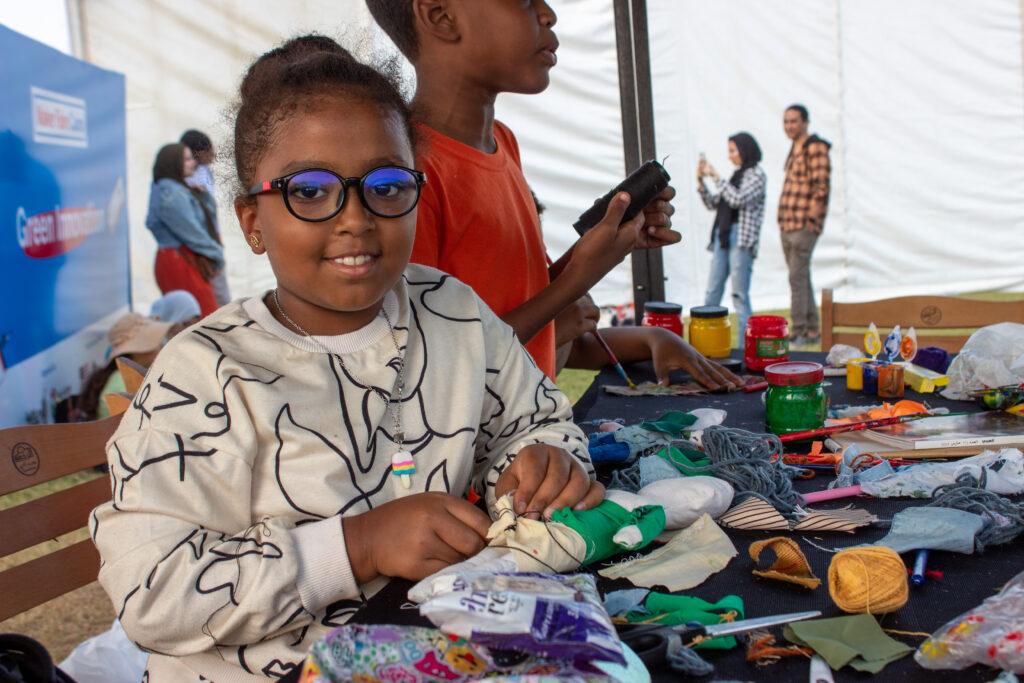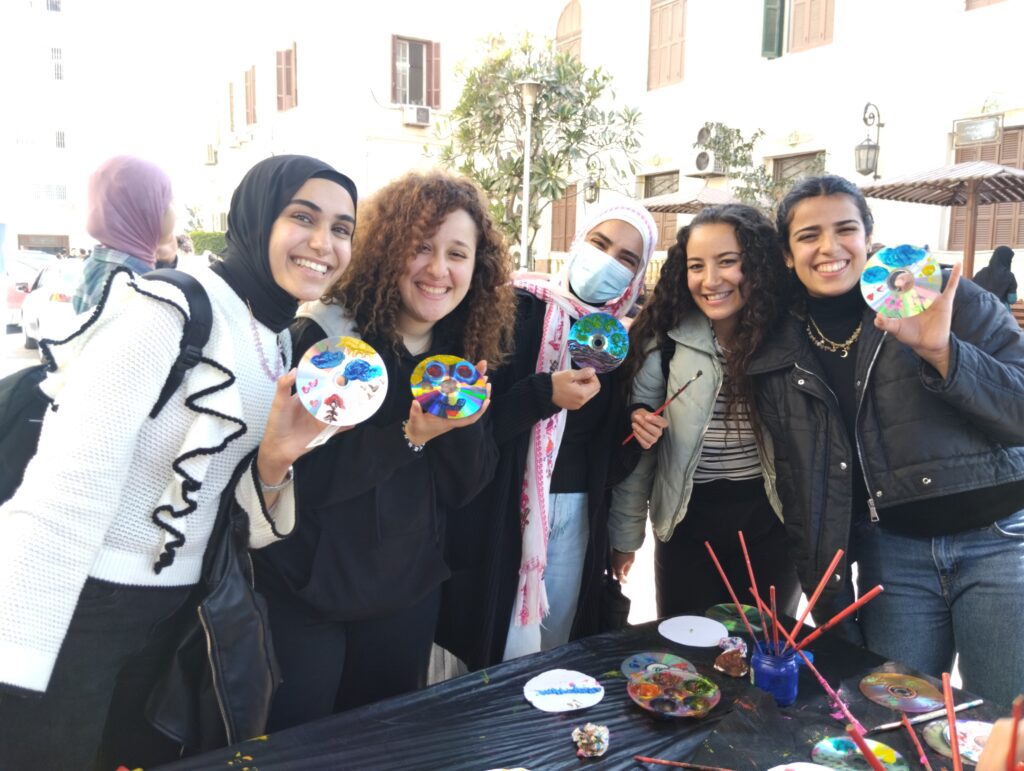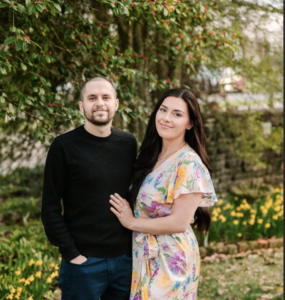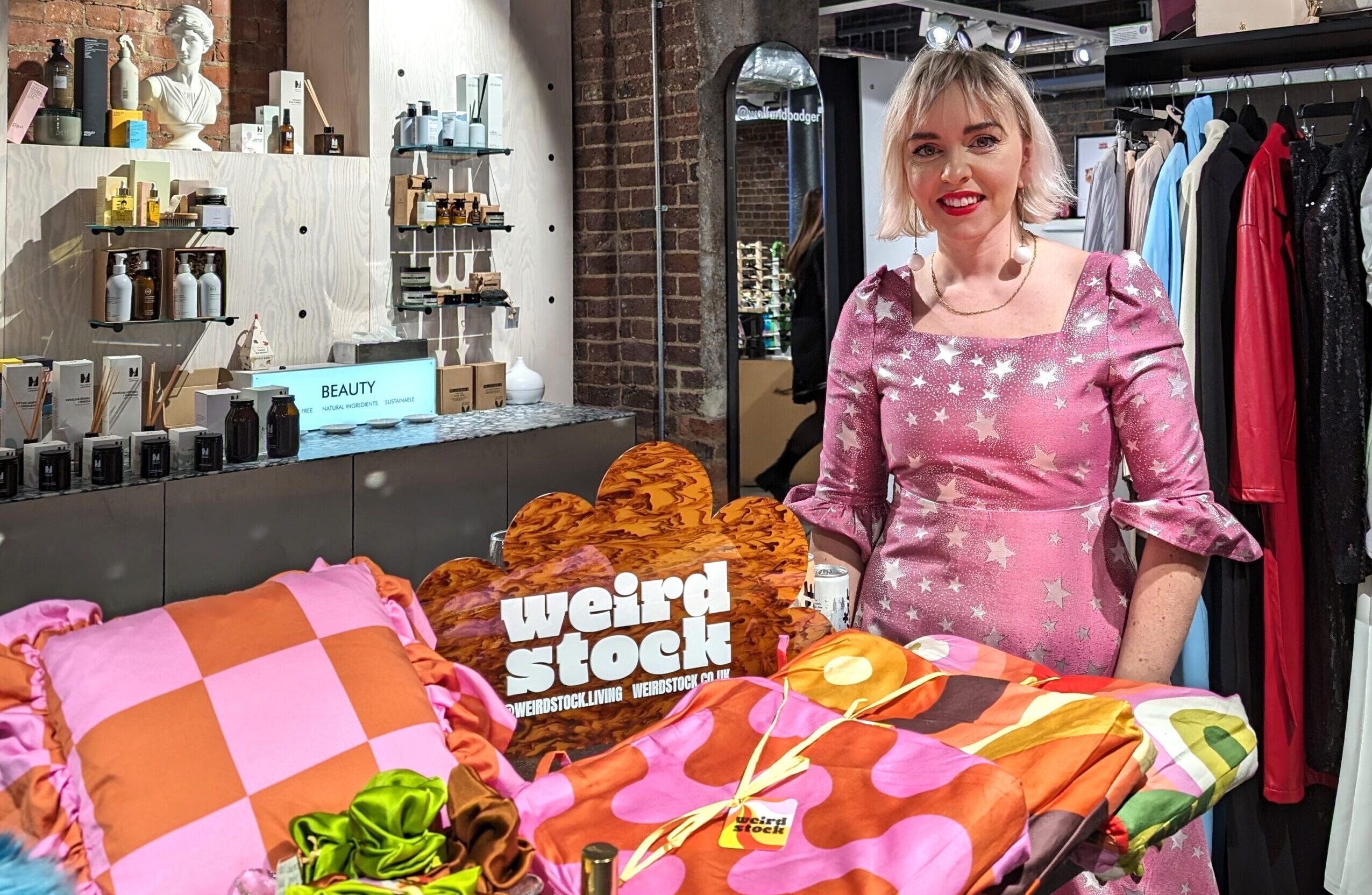Meet Nada Sayed, a visionary entrepreneur from Egypt whose journey is as inspiring as it is impactful. Through her initiative, Tram Alwaan, she seamlessly merges art, environmental consciousness, and community empowerment. From overcoming personal challenges to navigating the complexities of being a female business leader, Nada’s story is a testament to resilience and creativity. In this interview, she shares her insights on using art for personal growth, the role of creative industries in connecting humans with nature and heritage, and her aspirations for the future of Tram Alwaan. Get ready to dive into a world where art, sustainability, and social impact converge.
What inspired you to integrate nature, waste, and various art forms into your creative process?
Once upon a time, a glass was broken by my hands and caused a lasting wound to me, but the wound was a source of light for me and others when I decided to learn how to reuse glass and live with my fear and make products from it and from waste such as plastic, paper and cloth.
Every time I use materials, it helps me discover something new inside and around me and when I’m searching for real myself I listen to nature to guide me and it was the source for everything around us and the waste materials made from it , so I’m trying to make connections between waste and nature
As a businesswoman in Egypt, what challenges have you faced in pursuing your passion for Tram Alwaan?
Gender bias: In many societies, including Egypt, gender bias and stereotypes can pose significant challenges for women in business. Women may face discrimination or limited opportunities based on traditional gender roles and expectations.
Limited access to resources: Businesswomen may face difficulties accessing capital, loans, and other financial resources needed to start or grow their ventures. This can be due to various factors, including unequal access to funding networks or biases in the financial sector.
Cultural norms and societal expectations: Societal expectations and cultural norms can create additional challenges for women in business. Balancing traditional gender roles, family responsibilities, and societal expectations may require extra effort and support.
Networking and mentorship opportunities: Building a strong network and finding mentorship opportunities can be more challenging for women, as they may have limited access to established networks and male-dominated industries.
Work-life balance: Striking a balance between professional and personal responsibilities can be particularly challenging for women. Managing family commitments, childcare, and household responsibilities alongside business pursuits can be demanding.
Lack of representation and role models: The absence of visible and successful female business leaders or role models can impact aspiring businesswomen’s confidence and hinder their professional growth.7. Legal and regulatory barriers: Certain legal and regulatory frameworks may present challenges for women entrepreneurs. These barriers can include restrictive business regulations, limited legal protections, and bureaucratic hurdles.
Despite these challenges, many women in Egypt and around the world have successfully overcome obstacles and achieved remarkable success in their entrepreneurial ventures. With the support of networks, mentorship, and advocacy for gender equality, women are challenging societal norms and reshaping the business landscape.

How do you navigate the pressures and expectations placed on you as a female entrepreneur in your community?
Build a strong support network: Surround yourself with a supportive network of mentors, peers, and like-minded individuals who can provide guidance and encouragement. Seek out communities or organizations that specifically support women in entrepreneurship, as they can offer valuable resources and networking opportunities.
Embrace your uniqueness: Recognize that being a female entrepreneur brings unique perspectives and strengths to the table. Embrace your individuality and use it as an advantage in your business endeavors. Focus on your strengths and leverage them to differentiate yourself in the market.
Set realistic expectations: Understand that you can’t please everyone, and it’s impossible to meet everyone’s expectations. Define your own vision of success and set realistic goals for yourself. Remember that success is a personal journey, and it’s important to stay true to your values and aspirations.
Develop confidence and resilience: Confidence in your abilities and resilience in the face of challenges are crucial attributes for any entrepreneur, regardless of gender. Cultivate self-belief by celebrating your achievements, seeking continuous learning, and surrounding yourself with positive influences. Develop resilience by learning from failures, adapting to setbacks, and staying persistent.
Seek out mentorship and role models: Look for successful female entrepreneurs who have navigated similar challenges and learn from their experiences. Seek mentorship from those who can provide guidance and advice based on their own journeys. Their insights can be invaluable in helping you navigate the pressures and expectations you face.
Advocate for gender equality: Use your position as a female entrepreneur to advocate for gender equality and empower other women in your community. By being a role model and actively supporting initiatives that promote diversity and inclusion, you can contribute to creating a more supportive and inclusive environment for women in entrepreneurship.
You mentioned using art as a form of expression to rebuild yourself. Can you elaborate on how this process has helped you overcome personal challenges?
Emotional expression: Art provides a non-verbal outlet for emotions that might be difficult to express verbally. Through art, individuals can visually represent and explore their feelings, experiences, and inner conflicts. This process can foster self-awareness, emotional release, and a deeper understanding of oneself.
Stress reduction: Engaging in art can be cathartic, allowing individuals to release pent-up emotions and reduce stress. Creating art can serve as a form of meditation, providing a calming and soothing effect on the mind and body.
Self-reflection and insight: The process of creating art often involves introspection and self-reflection. By focusing on the artistic process and the symbolism within their artwork, individuals can gain insights into their thoughts, beliefs, and patterns of behavior. This self-awareness can lead to personal growth and a better understanding of oneself.
Empowerment and self-confidence: Artistic expression can foster a sense of empowerment and self-confidence. The act of creating something meaningful and unique can boost self-esteem and instill a sense of accomplishment. Through art, individuals can challenge self-limiting beliefs and develop a more positive self-image.
Problem-solving and resilience: Engaging in art requires creativity and problem-solving skills. By experimenting with different materials, techniques, and approaches, individuals can develop resilience and adaptive thinking.
Could you discuss some of the most significant experiences or projects you’ve been involved with, particularly those with international organizations like Tdh, Plan, Care, and AISAC?
One of my favourite experiences with AIESEC Egypt when I worked with Livia from Brazil at her first time in Egypt but we worked together for 40 days and made alot of adventures in many local communities in Cairo like Sudan community

In what ways do you believe creative industries can foster connections between humans, nature, environment, and heritage?
Creative industries have the potential to foster connections between humans, nature, environment, and heritage in several ways:
Artistic expression and storytelling: Creative industries encompass various art forms, such as visual arts, literature, music, film, and performing arts. These art forms provide platforms for artists to express their experiences, emotions, and perspectives related to nature, the environment, and heritage. Through their creations, artists can inspire and engage audiences, fostering a deeper connection and appreciation for these aspects of the world.
Cultural preservation and representation: Creative industries play a vital role in preserving and representing cultural heritage and traditions. Artists and cultural practitioners can utilize their creativity to showcase traditional practices, rituals, and stories related to nature, the environment, and heritage. This promotes cultural diversity and helps preserve traditional knowledge and practices that are often rooted in the natural world.
Environmental awareness and activism: Creative industries can raise awareness about environmental issues and inspire action for conservation and sustainability. Artists can use their platforms to address topics such as climate change, biodiversity loss, pollution, and resource depletion. Through visual arts, films, music, and other creative mediums, they can evoke emotions, challenge perspectives, and encourage individuals to take steps towards a more sustainable future.
Place-making and community engagement: Creative industries can contribute to place-making, creating spaces that celebrate and connect with the natural environment and heritage. Public art installations, community gardens, and cultural events can enhance the sense of place and community identity, fostering a stronger bond between humans, nature, environment, and heritage. These initiatives often involve collaboration between artists, local communities, and environmental organizations.
Education and interpretation: Creative industries can serve as powerful tools for education and interpretation. They can communicate complex environmental and heritage concepts in engaging and accessible ways. Museums, exhibitions, interpretive centers, and interactive experiences can use creative techniques to provide immersive and memorable learning experiences, promoting a deeper understanding and connection with nature, environment, and heritage.
Sustainable design and innovation: Creative industries can contribute to sustainable design and innovation practices. Designers, architects, and engineers can incorporate principles of sustainability, biomimicry, and cultural sensitivity into their work, creating structures and products that harmonize with nature and heritage. This approach fosters a connection between humans and their surroundings, emphasizing the importance of preserving and respecting the natural environment and cultural heritage.
How do you approach the representation of the concept of ‘home’ and its connection to the environment in your work
Exploring the emotional connection: ‘Home’ is often associated with a sense of belonging, comfort, and emotional attachment. In creative work, you can explore the emotional aspects of ‘home’ by depicting the ways in which individuals connect with their environment and how it shapes their sense of belonging. This can be done through storytelling, visual representations, or even poetic expressions
Depicting the physical environment: The physical environment plays a significant role in shaping our idea of ‘home.’ Creative work can focus on capturing the essence of different environments, whether it’s rural landscapes, urban cityscapes, or coastal regions. Through visual arts, photography, or even descriptive writing, you can portray the unique characteristics of these environments and how they contribute to the concept of ‘home.’
Nature as a part of home: Nature is often intertwined with our sense of ‘home.’ Creative work can explore the relationship between humans and the natural environment, highlighting how nature nurtures and sustains us. This can involve showcasing natural landscapes, wildlife, or incorporating elements of nature into artistic creations.
Sustainability and environmental consciousness: In today’s context, it’s important to consider the environmental impact of our homes and living spaces. Creative work can address sustainable practices, sustainable architecture, or eco-friendly lifestyles. It can promote awareness of environmental issues and inspire individuals to make conscious choices that contribute to a healthier and more sustainable home and environment.
Cultural and historical perspectives: ‘Home’ is deeply influenced by cultural and historical contexts. Creative work can delve into the cultural practices, traditions, and architectural styles that define a sense of ‘home’ in different communities or regions. By exploring the historical and cultural dimensions of ‘home,’ you can shed light on the diverse ways in which people connect with their environment and herita
Can you share some insights into your eco-exhibitions, camps, workshops, and gifts? How do these initiatives contribute to your vision for Tram Alwaan?
We believe in partnership so we contribute by venue , media, photography
What advice would you offer to aspiring entrepreneurs, particularly those who want to merge their passion for art with environmental consciousness?
Be focused and real don’t afraid to be yourself.
Looking ahead, what are your hopes and aspirations for the future of Tram Alwaan and your broader impact on society and the environment?
I hope to make safe spaces for kids and women in every governments to learn and express through arts.
Lastly, how can individuals and organizations support your mission and get involved with Tram Alwaan?
By supporting us, helping to get fund to make more impact, speard the word through different platforms, volunteer with us ,






